
A Manual of Anti-Racist Architecture Education
WAI Architecture Think Tank
(Loudreaders Publishers, 2023)
WAI Architecture Think Tank
(Loudreaders Publishers, 2023)
A Manual of Anti-Racist Architecture Education is an unprecedented tool that centers architecture and architectural education in the struggles against racism and the material legacy of white supremacy.
A valuable resource for designers, educators, students, and anybody who’s lives are affected by the built and destroyed environment, this anti-racist manual unveils how architecture and architectural education is shaped by the construction of race and outlines ways to imagine emancipatory architectures. Divided in three parts, the manual discusses economic, cultural, political, spatial, and historical hurdles that must be overcome before, during, and after school. An appendix presents an overview on the precarious labor of anti-racist education. Through diagrams, analytical texts, and manifestos, A Manual of Anti-Racist Architecture Education asks many questions about the current state of architecture and imagines a future centered on social and ecological justice.
Written, illustrated, and designed by architects, educators, and authors Cruz Garcia and Nathalie Frankowski of WAI Architecture Think Tank, A Manual of Anti-Racist Architecture Education is equally a tool for activism, design education, and worldmaking.
Loudreaders
Hardcover
62 Pages
Dimensions: 10.2 in x 10.2 in x .5in or 259mm x 259mm x 12.7mm Weight: 0.51 kg or 1.12 lb
ISBN: 978-2-9544145-0-8
Download Here.
Loudreaders.com
A valuable resource for designers, educators, students, and anybody who’s lives are affected by the built and destroyed environment, this anti-racist manual unveils how architecture and architectural education is shaped by the construction of race and outlines ways to imagine emancipatory architectures. Divided in three parts, the manual discusses economic, cultural, political, spatial, and historical hurdles that must be overcome before, during, and after school. An appendix presents an overview on the precarious labor of anti-racist education. Through diagrams, analytical texts, and manifestos, A Manual of Anti-Racist Architecture Education asks many questions about the current state of architecture and imagines a future centered on social and ecological justice.
Written, illustrated, and designed by architects, educators, and authors Cruz Garcia and Nathalie Frankowski of WAI Architecture Think Tank, A Manual of Anti-Racist Architecture Education is equally a tool for activism, design education, and worldmaking.
Loudreaders
Hardcover
62 Pages
Dimensions: 10.2 in x 10.2 in x .5in or 259mm x 259mm x 12.7mm Weight: 0.51 kg or 1.12 lb
ISBN: 978-2-9544145-0-8
Download Here.
Loudreaders.com
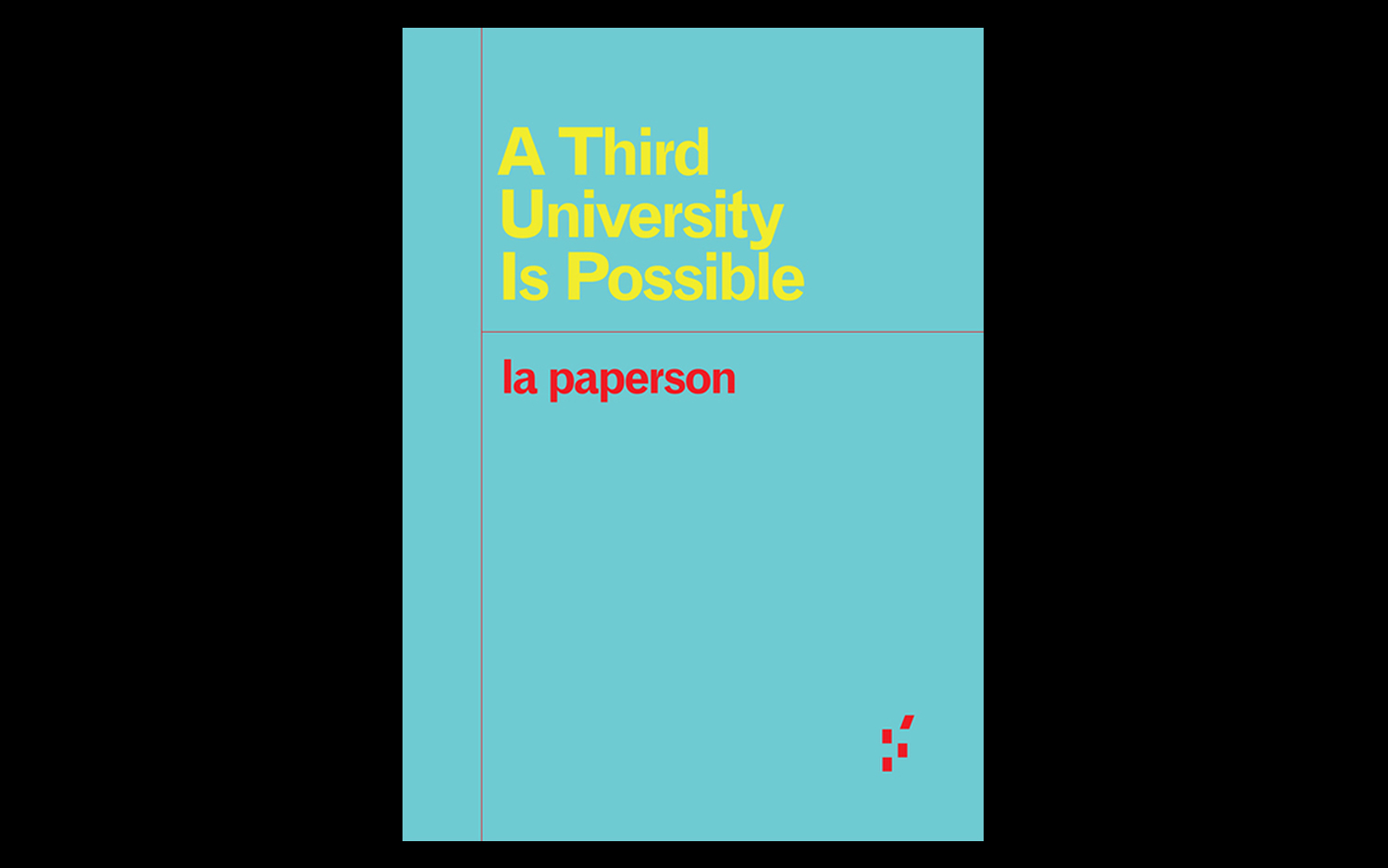
A Third University is Possible
la paperson
(University of Minnesota Press, 2017)
la paperson
(University of Minnesota Press, 2017)
A Third University is Possible unravels the intimate relationship between the more than 200 US land grant institutions, American settler colonialism, and contemporary university expansion. Author la paperson cracks open uncanny connections between Indian boarding schools, Black education, and missionary schools in Kenya; and between the Department of Homeland Security and the University of California. Central to la paperson’s discussion is the “scyborg,” a decolonizing agent of technological subversion.
Drawing parallels to Third Cinema and Black filmmaking assemblages, A Third University is Possible ultimately presents a framework for hotwiring university “machines” to the practical work of decolonization.
ISBN978-1-4529-5846-0
ISSN2373-5074
Download Here.
Read Online Here.
Drawing parallels to Third Cinema and Black filmmaking assemblages, A Third University is Possible ultimately presents a framework for hotwiring university “machines” to the practical work of decolonization.
ISBN978-1-4529-5846-0
ISSN2373-5074
Download Here.
Read Online Here.

Architecture of Counterrevolution The French Army in Northern Algeria
Samia Henni
(Zurich: gta Verlag, 2023.)
Samia Henni
(Zurich: gta Verlag, 2023.)
After over 120 years of French colonial rule in Algeria, the growing aspirations for independence culminated in the Algerian Revolution of 1954, which lasted until 1962. In order to combat the uprisings, the French civilian and military authorities reorganized the entire territory of the country, swiftly erected new infrastructures and pursued building policies that were ultimately intended to stabilize French dominance in Algeria. The study describes the architectural responses undertaken in the midst of this protracted and bloody armed conflict. It analyses their origins, evolutions and objectives, identifies the actors involved and reveals the underlying design methods.
2023. 16.5 × 24.5 cm, PDF
336 pages, 73 illustrations
ISBN 978-3-85676-452-4
Text in English
Download Architecture of the Counterrevolution here.
GTA Website link.
2023. 16.5 × 24.5 cm, PDF
336 pages, 73 illustrations
ISBN 978-3-85676-452-4
Text in English
Download Architecture of the Counterrevolution here.
GTA Website link.

Are Prisons Obsolete?
Angela Y. Davis
(Seven Stories Press, 2003)
Angela Y. Davis
(Seven Stories Press, 2003)
A short, impassioned, argument for abolition. Davis eloquently points out that mass incarceration has had little or no effect on crime, how disproportionate numbers of the poor and minorities end up in prison, and the obscene profits the system generates. Who needs it!
"In this extraordinary book, Angela Davis challenges us to confront the human rights catastrophe in our jails and prisons. As she so convincingly argues, the contemporary US practice of super-incarceration is closer to new age slavery that to any recognizable system of 'criminal justice'..." —Mike Davis
Download Are Prisons Obsolete? Here.
"In this extraordinary book, Angela Davis challenges us to confront the human rights catastrophe in our jails and prisons. As she so convincingly argues, the contemporary US practice of super-incarceration is closer to new age slavery that to any recognizable system of 'criminal justice'..." —Mike Davis
Download Are Prisons Obsolete? Here.
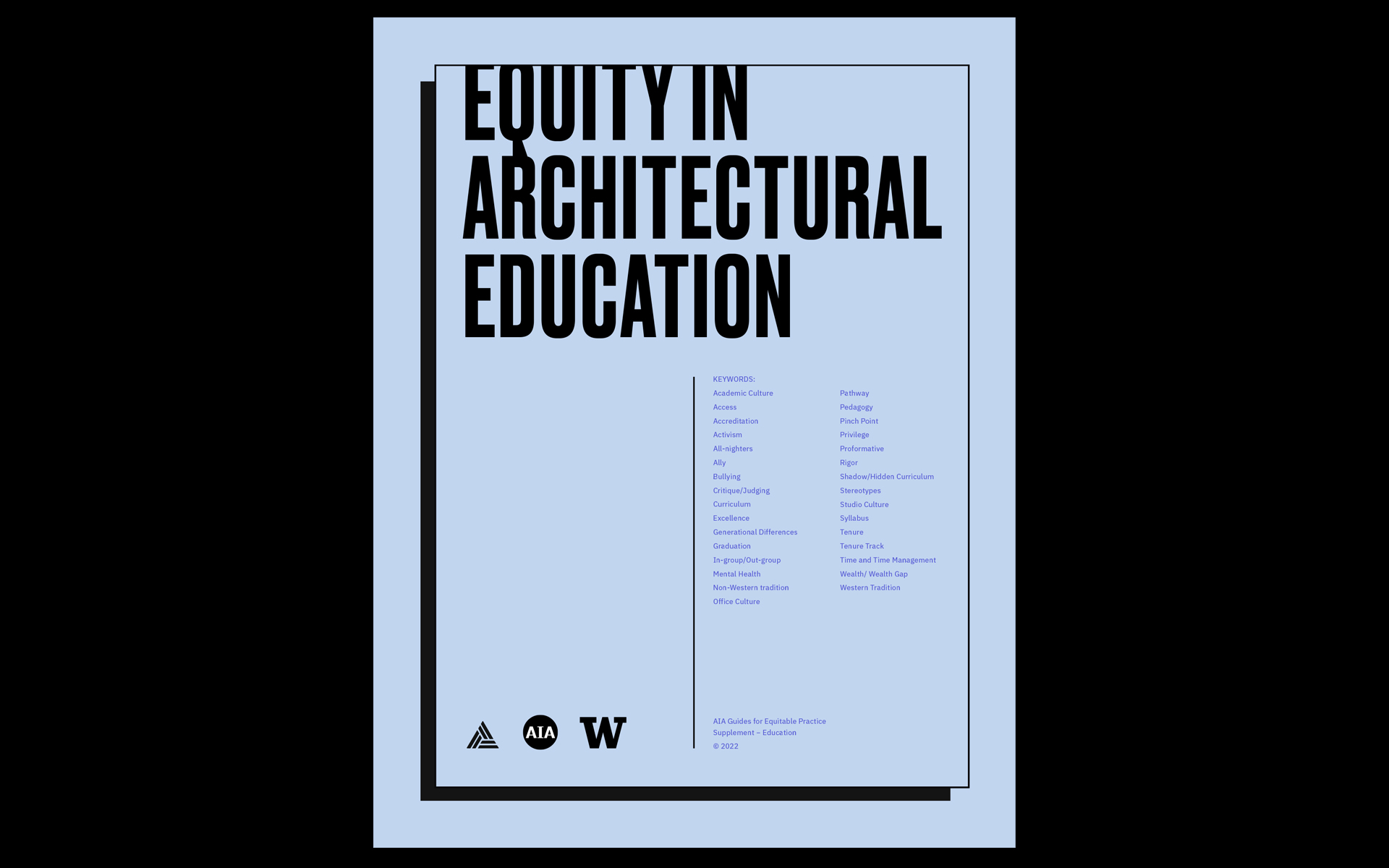
Equity in Architectural Education
AIA / ACSA
(AIA/ ACSA, 2022)
AIA / ACSA
(AIA/ ACSA, 2022)
The American Institute of Architects (AIA) and the Association of Collegiate Schools of Architecture (ACSA) have published a supplementary edition of the Guides for Equitable Practice, focusing on schools and institutions.
Equity in Architectural Education provides actions and prompts intended to inspire discussions about creating welcoming environments to attract and retain those currently underrepresented in academia and in the profession. This resource defines the concept of culture in architectural education while describing impacts in the workforce. Equity in Architectural Education deepens the understanding of architecture education culture for anyone involved with it, students or professionals.
Office and school cultures feed and reinforce each other, and long-standing traditions, viewpoints, and biases in academia are strong. Attaining an increase in diversity and creating a welcoming culture for all within academia accelerates progress towards equity, diversity, and inclusion (EDI) in each sector of the profession.
Download Equity in Architectural Education Here.
acsa-arch.org/resource/aia-acsa-equity-in-architectural-education/
Equity in Architectural Education provides actions and prompts intended to inspire discussions about creating welcoming environments to attract and retain those currently underrepresented in academia and in the profession. This resource defines the concept of culture in architectural education while describing impacts in the workforce. Equity in Architectural Education deepens the understanding of architecture education culture for anyone involved with it, students or professionals.
Office and school cultures feed and reinforce each other, and long-standing traditions, viewpoints, and biases in academia are strong. Attaining an increase in diversity and creating a welcoming culture for all within academia accelerates progress towards equity, diversity, and inclusion (EDI) in each sector of the profession.
Download Equity in Architectural Education Here.
acsa-arch.org/resource/aia-acsa-equity-in-architectural-education/

Forensis: The Architecture of Public Truth
Forensic Architecture, ed.
(Sterberg Press and Forensic Architecture, 2014)
Forensic Architecture, ed.
(Sterberg Press and Forensic Architecture, 2014)
Forensics originated from the term “forensis” which is Latin for “pertaining to the forum.” The Roman forum was a multidimensional space of negotiation and truth-finding in which humans as well as objects participated in politics, law, and the economy. With the advent of modernity, forensics shifted to refer exclusively to the courts of law and to the use of medicine, and today as a science in service to the law. The present use of forensics, along with its popular representations have become increasingly central to the modes by which states police and govern their subjects.
By returning to forensis this book seeks to unlock forensics’ original potential as a political practice and reorient it. Inverting the direction of the forensic gaze it designates a field of action in which individuals and organizations detect and confront state violations.
The condition of forensis is one in which new technologies for mediating the “testimony” of material objects—bones, ruins, toxic substances, landscapes, and the contemporary medias in which they are captured and represented—are mobilized in order to engage with struggles for justice, systemic violence, and environmental transformations across the frontiers of contemporary conflict.
This book presents the work of the architects, artists, filmmakers, lawyers, and theorists who participated directly in the “Forensic Architecture” project in the Centre for Research Architecture at Goldsmiths University of London, as well as the work of associates and guests. It includes forensic investigations undertaken by the project and its collaborators aimed at producing new kinds of evidence for use by international prosecutorial teams, political organizations, NGOs, and the UN. It also brings together research and essays that situate contemporary forensic practices within broader political, historical, and aesthetic discourse.
March 2014, English
17×24 cm, 744 pages, 825 color and b/w ill., softcover with dust jacket
ISBN 978-3-95679-011-9
Download Forensis Here.
By returning to forensis this book seeks to unlock forensics’ original potential as a political practice and reorient it. Inverting the direction of the forensic gaze it designates a field of action in which individuals and organizations detect and confront state violations.
The condition of forensis is one in which new technologies for mediating the “testimony” of material objects—bones, ruins, toxic substances, landscapes, and the contemporary medias in which they are captured and represented—are mobilized in order to engage with struggles for justice, systemic violence, and environmental transformations across the frontiers of contemporary conflict.
This book presents the work of the architects, artists, filmmakers, lawyers, and theorists who participated directly in the “Forensic Architecture” project in the Centre for Research Architecture at Goldsmiths University of London, as well as the work of associates and guests. It includes forensic investigations undertaken by the project and its collaborators aimed at producing new kinds of evidence for use by international prosecutorial teams, political organizations, NGOs, and the UN. It also brings together research and essays that situate contemporary forensic practices within broader political, historical, and aesthetic discourse.
March 2014, English
17×24 cm, 744 pages, 825 color and b/w ill., softcover with dust jacket
ISBN 978-3-95679-011-9
Download Forensis Here.

From Land Grab to LandBack
LandBack Landscape Poems
De la destitución a la restitución
Poemario de paisajes de restitución
WAI Architecture Think Tank, ed.
(Loudreaders Publishers, 2023)
LandBack Landscape Poems
De la destitución a la restitución
Poemario de paisajes de restitución
WAI Architecture Think Tank, ed.
(Loudreaders Publishers, 2023)
Part Rematriation manifesto, part anti-colonial propaganda pamphlet, part anti-imperialist exhibition catalog, From Land Grab to LandBack / LandBack Landscape Poems brings in print format calls, strategies, and prose against the ecological and social spoliation produced by different forms of colonialism.
Produced in two separate, continuous publications, From Land Grab to LandBack / LandBack Landscape Poems documents a year of texts, projects, and reflections by architects, artists, filmmakers, legal scholars, activists, poets, writers, and educators exploring calls for Land Back from Palestine to Vieques, from South Africa to the Great Plains.
The publication includes contributions Sikowis Nobiss and the Great Plains Action Society, Samia Henni, Jason Mena, Pete Goche, Douglas Spencer, Colectiva Feminista en Construcción, Bibi Naniki Reyes Ocasio, Caney Orocovis, CAN Jibaro, Simphiwe Mlambo and students from the GSA Johannesburg, Papel Machete, Marakianí Olivieri, Dima Srouji, Mariana G. Iriarte Mastronardo, Peter Zuroweste, Hasan Shurrab, Nadia Huggins, Samiha Meem, Killian O’ Dochartaigh & Edward Lawrenson, Marili Pizarro, Jason Fitzroy Jeffers, Jonathan David Kane, Vashti Harrison, Audrey Jean-Baptiste and Maxime Jean-Baptiste, Alexandra Pagán Vélez, Post-Novis, Hilary Wiese, Rose Florian, Christopher Rey Perez, Luis Othoniel Rosa, and WAI Architecture Think Tank / Nathalie Frankowski & Cruz Garcia.
En parte manifiesto de rematriación, en parte panfleto de propaganda anticolonial, en parte catálogo de exposición antiimperialista, De la destitución a la restitución/Poemario de paisajes de restitución presenta en formato impreso llamados, estrategias y prosa contra el expolio ecológico y social producido por diferentes formas de colonialismo.
Producido en dos publicaciones separadas y continuas, De la destitución a la restitución/Poemario de paisajes de restitución documenta un año de textos, proyectos y reflexiones de arquitectos, artistas, cineastas, juristas, activistas, poetas, escritores y educadores que exploran los llamados a Land Back. desde Palestina hasta Vieques, desde Sudáfrica hasta las Grandes Llanuras.
La publicación incluye contribuciones de Sikowis Nobiss y Great Plains Action Society, Samia Henni, Jason Mena, Pete Goche, Douglas Spencer, Colectiva Feminista en Construcción, Bibi Naniki Reyes Ocasio, Caney Orocovis, CAN Jibaro, Simphiwe Mlambo y estudiantes de la GSA Johannesburgo. , Papel Machete, Marakianí Olivieri, Dima Srouji, Mariana G. Iriarte Mastronardo, Peter Zuroweste, Hasan Shurrab, Nadia Huggins, Samiha Meem, Killian O' Dochartaigh & Edward Lawrenson, Marili Pizarro, Jason Fitzroy Jeffers, Jonathan David Kane, Vashti Harrison, Audrey Jean-Baptiste y Maxime Jean-Baptiste, Alexandra Pagán Vélez, Post-Novis, Hilary Wiese, Rose Florian, Christopher Rey Perez, Luis Othoniel Rosa y WAI Architecture Think Tank / Nathalie Frankowski & Cruz Garcia.
Edition and Graphic Design:
WAI Architecture Think Tank
Nathalie Frankowski & Cruz Garcia
Loudreaders
Paperback Pamphlets
112 Pages
Dimensions: 170mm x 255mm
ISBN: 978-2-9544145-2-2
Download / Descarga From Land Grab to LandBack / De la destitución a la restitución
Download / Descarga LandBack Landscape Poems / Poemario de paisajes de restitución
Loudreaders.com
Produced in two separate, continuous publications, From Land Grab to LandBack / LandBack Landscape Poems documents a year of texts, projects, and reflections by architects, artists, filmmakers, legal scholars, activists, poets, writers, and educators exploring calls for Land Back from Palestine to Vieques, from South Africa to the Great Plains.
The publication includes contributions Sikowis Nobiss and the Great Plains Action Society, Samia Henni, Jason Mena, Pete Goche, Douglas Spencer, Colectiva Feminista en Construcción, Bibi Naniki Reyes Ocasio, Caney Orocovis, CAN Jibaro, Simphiwe Mlambo and students from the GSA Johannesburg, Papel Machete, Marakianí Olivieri, Dima Srouji, Mariana G. Iriarte Mastronardo, Peter Zuroweste, Hasan Shurrab, Nadia Huggins, Samiha Meem, Killian O’ Dochartaigh & Edward Lawrenson, Marili Pizarro, Jason Fitzroy Jeffers, Jonathan David Kane, Vashti Harrison, Audrey Jean-Baptiste and Maxime Jean-Baptiste, Alexandra Pagán Vélez, Post-Novis, Hilary Wiese, Rose Florian, Christopher Rey Perez, Luis Othoniel Rosa, and WAI Architecture Think Tank / Nathalie Frankowski & Cruz Garcia.
En parte manifiesto de rematriación, en parte panfleto de propaganda anticolonial, en parte catálogo de exposición antiimperialista, De la destitución a la restitución/Poemario de paisajes de restitución presenta en formato impreso llamados, estrategias y prosa contra el expolio ecológico y social producido por diferentes formas de colonialismo.
Producido en dos publicaciones separadas y continuas, De la destitución a la restitución/Poemario de paisajes de restitución documenta un año de textos, proyectos y reflexiones de arquitectos, artistas, cineastas, juristas, activistas, poetas, escritores y educadores que exploran los llamados a Land Back. desde Palestina hasta Vieques, desde Sudáfrica hasta las Grandes Llanuras.
La publicación incluye contribuciones de Sikowis Nobiss y Great Plains Action Society, Samia Henni, Jason Mena, Pete Goche, Douglas Spencer, Colectiva Feminista en Construcción, Bibi Naniki Reyes Ocasio, Caney Orocovis, CAN Jibaro, Simphiwe Mlambo y estudiantes de la GSA Johannesburgo. , Papel Machete, Marakianí Olivieri, Dima Srouji, Mariana G. Iriarte Mastronardo, Peter Zuroweste, Hasan Shurrab, Nadia Huggins, Samiha Meem, Killian O' Dochartaigh & Edward Lawrenson, Marili Pizarro, Jason Fitzroy Jeffers, Jonathan David Kane, Vashti Harrison, Audrey Jean-Baptiste y Maxime Jean-Baptiste, Alexandra Pagán Vélez, Post-Novis, Hilary Wiese, Rose Florian, Christopher Rey Perez, Luis Othoniel Rosa y WAI Architecture Think Tank / Nathalie Frankowski & Cruz Garcia.
Edition and Graphic Design:
WAI Architecture Think Tank
Nathalie Frankowski & Cruz Garcia
Loudreaders
Paperback Pamphlets
112 Pages
Dimensions: 170mm x 255mm
ISBN: 978-2-9544145-2-2
Download / Descarga From Land Grab to LandBack / De la destitución a la restitución
Download / Descarga LandBack Landscape Poems / Poemario de paisajes de restitución
Loudreaders.com

Green Reconstruction: A Curricular Toolkit for the Built Environment
Reinhold Martin, Jacob R. Moore, and Jordan Steingard, Eds.
(The Temple Hoyne Buell Center for the Study of American Architecture
Columbia University,2022)
Reinhold Martin, Jacob R. Moore, and Jordan Steingard, Eds.
(The Temple Hoyne Buell Center for the Study of American Architecture
Columbia University,2022)
Change is learned. On the streets and in the public sphere, imagination, knowledge, and know-how go hand in hand. At a time of mounting social and ecological turmoil, planning and designing a just, equitable built environment requires professional focus anchored in intellectual ambition. Rote allegiances to orthodoxy must reorient toward new realities. Professional education, in short, must be rethought. For the arts and sciences of the built environment, change therefore begins in the classroom, as a shared learning that rebuilds the imagination from the ground up: Green Reconstruction.
Green Reconstruction is an outline, an open work, for the repair of a world ravaged by three intersecting crises—of mutual care, of racial oppression, and of climate, all intersecting in turn with economic inequality—that moves along two axes, the Green axis of ecological transformation, and the gilded axis of material redistribution, or Reconstruction. The Green axis refers to the ecological and economic ambitions of proposals like the Green New Deal and its counterparts around the world, all of which continue to merit serious academic and public attention. The second axis recovers the unfinished project of what W. E. B. Du Bois called, in Black Reconstruction in America (1935), “abolition democracy,” and with it, the political and economic restructuring of a system for which the expropriation of Black and Brown lives is business as usual, as racial and ecological apartheid remain global norms.
More specifically for the arts and sciences of the built environment, Green Reconstruction names a new curriculum, a change of course. By this we recognize the central role of professional, academically sanctioned expertise in constructing and maintaining a status quo, including a status quo nominally devoted to perpetual innovation. To mean anything and to change anything, Green Reconstruction must speak from below; but to endure, it must find its own designers, planners, and technicians. Such figures, both scholars and practitioners, link the powers below with the powers above, with the aim of supplying technical equipment with which to make things change.
To assist in teaching these questions and answering them the Buell Center has fashioned, with the help of many, this curricular toolkit for professional education in the planning and design of the built environment. It is organized to suggest different ways of learning together. Introductory material lays out the stakes and goals; a dossier of assessments and suggestions regarding how we learn offers pre-curricular back doors into long-established pedagogical practices, through which new strategies might be introduced. To activate these possibilities, a subsequent section outlines sample course content with an “object lesson” connecting three small American cities, that raises questions that must be addressed for anything like Green Reconstruction to be conceivable. This section is divided between a planning-oriented description of these cities from the perspective of built environment professionals working in each, and an architecture-oriented visual survey of their respective fabrics. A brief conclusion puts the sample material in context, looking to the challenges ahead.
Released digitally and in print, Green Reconstruction: A Curricular Toolkit for the Built Environment is available for no cost to anyone interested in the relationship between curricular and societal change. The PDF is available for download here, and the print edition, for which limited quantities are available, can be requested here.
We note emphatically: This research is preliminary, as are the corresponding suggestions. None derives from specialized expertise but rather, from open, unwieldy conversations of the sort we have tried to model. We assemble it here as an invitation to join these conversations and to start new ones, and to bring to them the deepest knowledge and the most profound imagination.
Download Here.
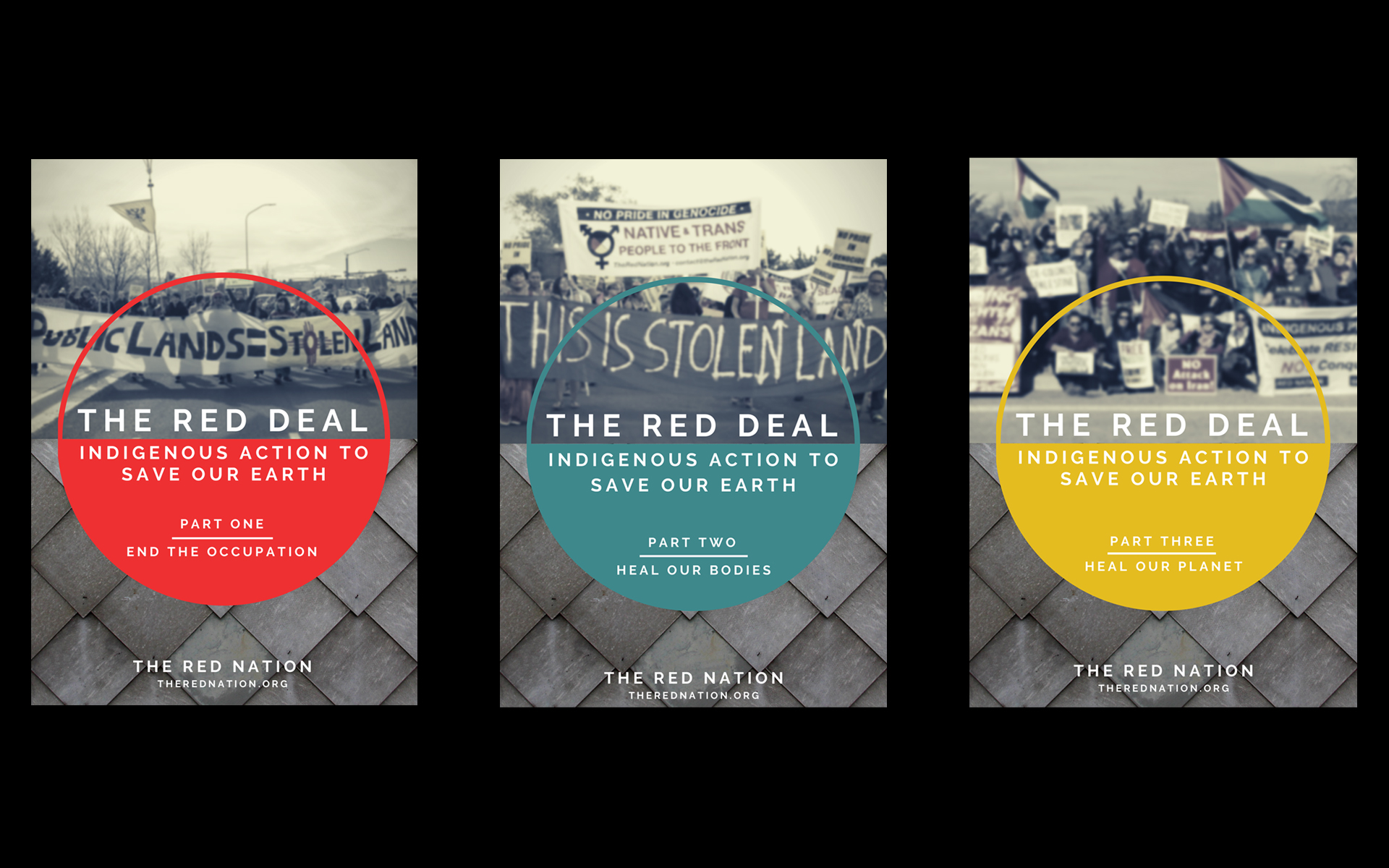
The Red Deal: Indigenous Action to Save our Earth
Part One: End the Occupation
Part Two:
Heal our Bodies
Part Three:
Heal our Planet
The Red Nation
Part One: End the Occupation
Part Two:
Heal our Bodies
Part Three:
Heal our Planet
The Red Nation
The Red Deal Indigenous Action To Save Our Earth is an action plan for decolonization in Turtle Island and beyond. The Red Deal is divided up into three parts. Part 1: Divest – end the occupation. Part 2: Heal our bodies- reinvest in our common humanity. Part 3: Heal Our Planet- reinvest in our common humanity. The Red Deal is a political plan to decolonize a world for all. Published by Red Media and Common Notions.
Download Part 1 Here.
Download Part 2 Here.
Download Part 3 Here.
therednation.org/
Download Part 1 Here.
Download Part 2 Here.
Download Part 3 Here.
therednation.org/
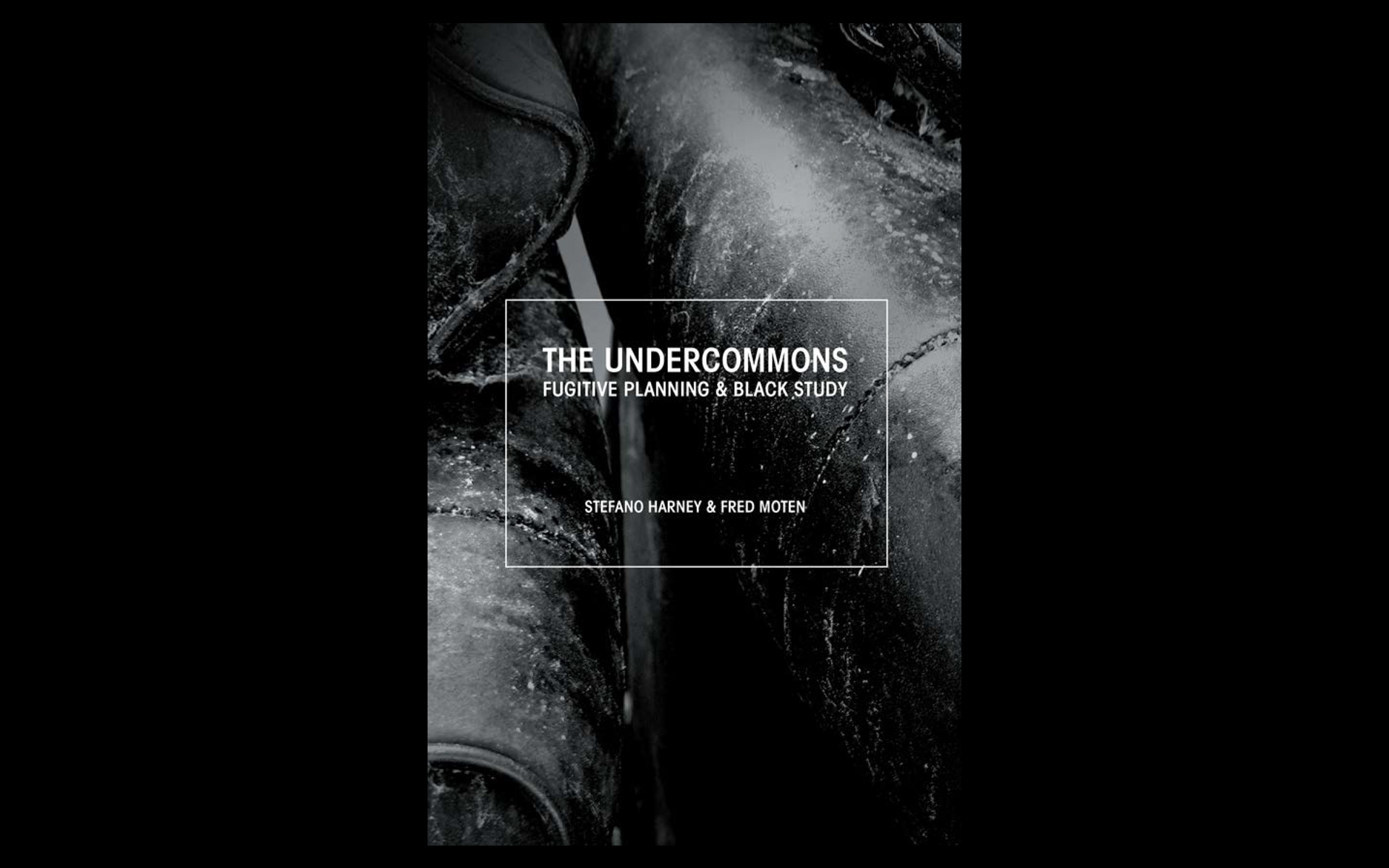
The Undercommons: Fugitive Planning & Black Study
Stefano Harney & Fred Moten
(Minor Compositions, 2013)
Stefano Harney & Fred Moten
(Minor Compositions, 2013)
In this series of essays Fred Moten and Stefano Harney draw on the theory and practice of the black radical tradition as it supports, inspires, and extends contemporary social and political thought and aesthetic critique. Today the general wealth of social life finds itself confronted by mutations in the mechanisms of control, from the proliferation of capitalist logistics through governance by credit and management of pedagogy. Working from and within the social poesis of life in the undercommons Moten and Harney develop and expand an array of concepts: study, debt, surround, planning, and the shipped. On the fugitive path of an historical and global blackness, the essays in this volume unsettle and invite the reader to the self-organised ensembles of social life that are launched every day and every night amid the general antagonism of the undercommons.
ISBN 978-1-57027-267-7
Download The Undercommons here.
ISBN 978-1-57027-267-7
Download The Undercommons here.
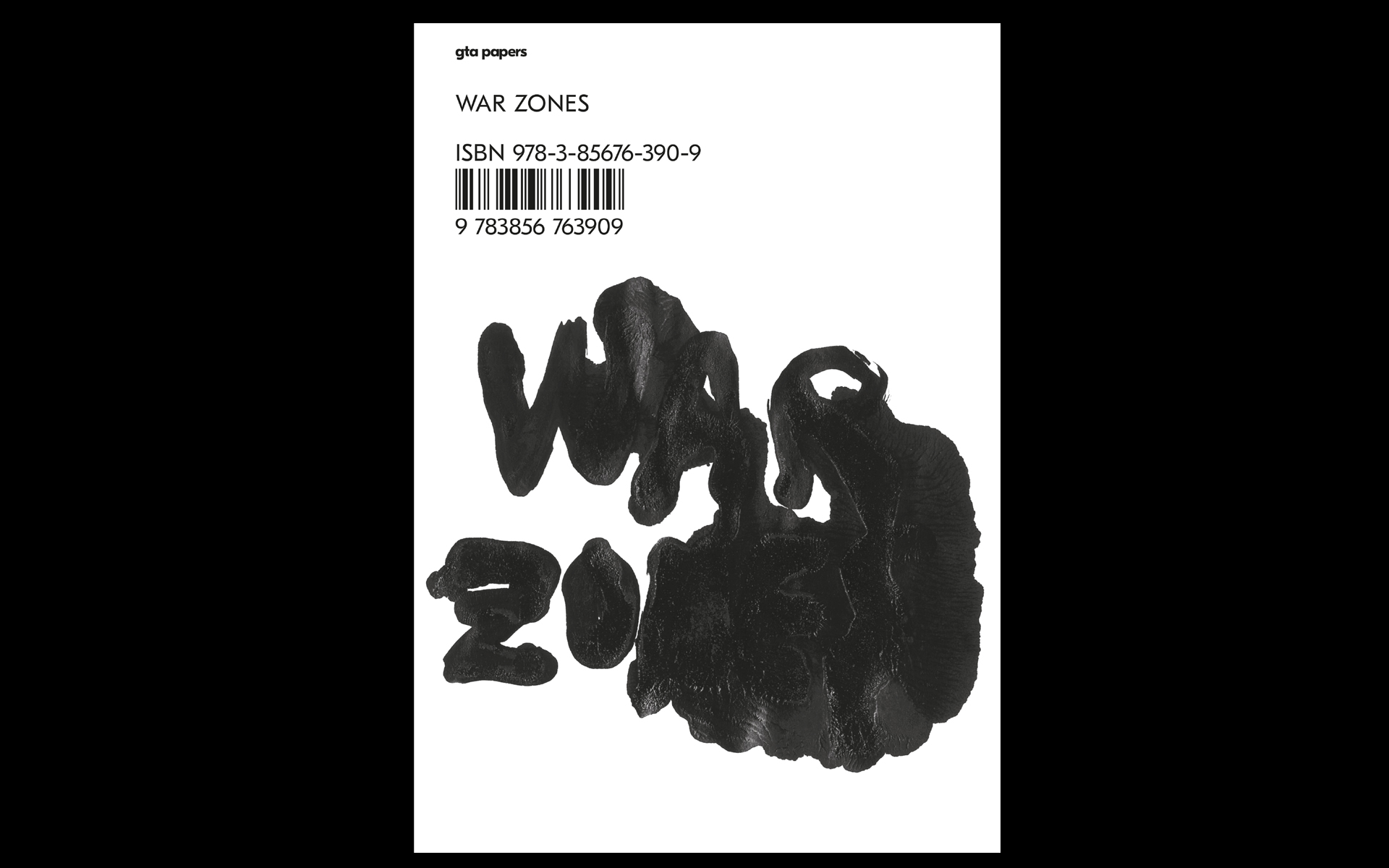
War Zones
Samia Henni, ed.
(Zurich: gta Verlag, 2019.)
Samia Henni, ed.
(Zurich: gta Verlag, 2019.)
After the Second World War and at the onset of the Cold War, warfare took different forms. War zones often lost their clear demarcations. People, landscapes, and built environments came to be subjugated to the strains and constraints of new forms of war that served both civil and military purposes. The contributions to War Zones investigate some of these implicit or explicit conditions, legacies, and impacts. From colonial or total war, asymmetric war or counterinsurgency, barricaded or besieged cities, refugee camps or borderlines, nuclear bunkers or ‘war ghosts’, to the state of emergency and drone warfare – these texts disclose the spatial aspects, statuses, and formation processes of past and current war zones.
2019. 21 × 29.7 cm, PDF
134 pages, 89 illustrations
ISBN 978-3-85676-440-1
Text in English
Download War Zones here.
GTA Website Link.
2019. 21 × 29.7 cm, PDF
134 pages, 89 illustrations
ISBN 978-3-85676-440-1
Text in English
Download War Zones here.
GTA Website Link.



